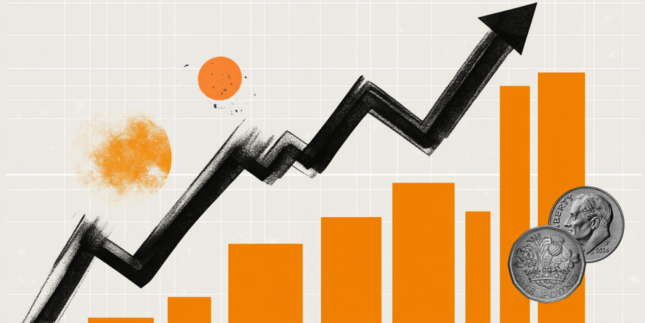Overview: The dollar remains offered and our ideas about it stalling as central banks push against the timing and extent of the easing the market is anticipating are being challenged. The Governor of the Reserve Bank of Australia and the Bank of England both warned higher rates may still be needed. Still, the momentum may be slowing. Meanwhile, the short squeeze continues to lift the Japanese yen, which is trading at its best level in two months. The PBOC has slashed its dollar reference rate and the yuan is near four-month highs after the greenback gapped lower.
Interest rates are lower. The 10-year bond yields are mostly 2-4 bp softer in Europe, and despite the anticipated EC deficit warnings, France’s premium over Germany is slightly less today and peripheral premiums have narrowed a little. The US 10-year Treasury yield is off nearly two basis points to 4.40%. Yesterday's 20-year Treasury auction yesterday was well received and today, the US Treasury sells $26 bln two-year floating rate notes and $15 bln 10-year TIPS. Equities are mixed. In Asia Pacific Japan, China, and Hong Kong markets slipped while demand for AI-related chip plays helped Taiwan’s index to new 19-month highs. Europe's Stoxx 600 is hovering around little changed levels, while US index futures are narrowly mixed. The S&P and NASDAQ have five-day advances in tow coming into today. The softer dollar and interest rates are helping lift gold, which approached $1995, its best level since November 3. Oil prices are consolidating after rallying more 6.3% over the past two sessions on ideas of further OPEC+ cuts that could be announced this weekend. January WTI reached almost $78.50 yesterday and is consolidating above $77 today.
Asia Pacific
The 10-year JGB yield near its lowest level in two months and the yen near its best level against the dollar since early October. Japanese officials could not have reasonably hoped for better price action. The need to intervene in either the foreign exchange or bond market has been reduced dramatically. The more favorable price action, however, has not helped Prime Minister Kishida. His public support continues to weaken. Surveys by the largest Japanese newspapers (Yomiuri, Asahi, and Mainichi) saw support fall to 21%-25%. In the past, below 30% support makes the PM politically vulnerable. Kishida's tax rebate, the extension of energy subsides, and support for low-income households has not impressed Japanese voters.
The minutes from the recent meeting by the Reserve Bank of Australia at which it lifted the overnight target rate a quarter-of-a-point to 4.35%. It was the first hike in five months. The minutes showed official frustration that consumer prices are not moderating quicker. The central bank expectations inflation to return to the top of its target range in late 2025, and this is based on assumptions of one-two more rate hikes. Separately, RBA Governor Bullock, speaking on a conference panel argued that Australian inflation is primarily supply driven. Yet, another hike would seem to require further upside surprises inflation and demand. Still, the swaps and futures market think it is more likely than not the RBA is done, and short-term rates are little changed to slightly softer today.
The dollar fell to a low near JPY148.10 just as the US foreign exchange market from the weekend yesterday. It peaked near JPY148.70 before Europe closed for the day, which was also the low seen in Asia on Monday. Follow-through selling in Asia saw sent the dollar to around JPY147.15 before stabilizing and returning to the JPY147.80 area in the European morning. There are options for $1.15 bln at JPY147.75 that expire tomorrow. Initial resistance is seen near JPY148.00 and then JPY148.50. The Australian dollar extended its recovery and reached almost $0.6465 yesterday. It finished strong and pushed slightly above $0.6585 before stalling. The 200-day moving average is about $0.6590. The Aussie backed off to around $0.6560 before catching a new bid Europe. The Chinese yuan has surged. It is at its best level in nearly four months. The US dollar was near CNY7.30 on November 13 and approached CNY7.13 today after gapping lower. This primarily reflects the broad dollar retreat but also a flurry of action by Chinese officials, including new fiscal support and aid to the property sector. The PBOC lowered the dollar's reference rate for the second consecutive session. Today's fix was almost 0.3% lower than yesterday at CNY7.1406. That is the most since July. The average forecast in Bloomberg's survey was for CNY7.1682. Note that the yuan's advance extended into the sixth consecutive session, the longest streak of the year.
Europe
Europe has a light economic diary until Thursday when the preliminary November PMI is due. We suspect the eurozone economy is bottoming, but positive news remains elusive. The preliminary PMI is expected to firm slightly but the manufacturing, services, and composite are seen remaining below the 50 boom/bust level. The ECB does not meet until December 14, and no one expects a change in policy. Fiscal policy is more central this week, following last week's German high court decision ruling against shifting funds earmarked for Covid to the environment using its off-balance sheet funds. Press reports suggest the EU will issue a report today critical of France's fiscal stance, while Germany and Italy are reportedly recognized as not fully compliant. Still, even at this late date, there seems to be no agreement on how to reform the EU's fiscal rules, as suspension of the Stability and Growth Agreement is to end.
Ahead of the UK's preliminary PMI on Thursday, Chancellor the Exchequer Hunt will deliver the Autumn Statement around midday in London tomorrow. There seems to be two key elements that people are watching closely. First, with inflation being halved, as Prime Minister Sunak had set as a goal at the start of the year, the troubled Tory government is looking at tax cuts to help revive its fortune, as the Hamas-Israel conflict divides Labour. Sunak seemed to steal some of Hunt's thunder by announcing yesterday that "we can, and we will cut taxes." Reports suggest Hunt could extend the "full expensing" of fixed asset investment (estimated cost GBP10 bln a year). There is also some talk of a cut in the inheritance tax (main rate stands at 40%). A 10-percentage point cut could cost GBP2 bln. Hunt may announce other measures, with limited fiscal impact, which could also support growth and investment. Second, Hunt expected to make good on a promise to expand Individual Savings Accounts (ISA) promised earlier this year that would allow the holding of less liquid assets, such as long-term asset fund vehicles. Separately, Bank of England Governor Bailey pushed back against the dovish move in the markets and warned that interest rates may have to be increased further. The swaps market barely reacted. The odds, for example, of a move in May, slipped to about 50% from about 56% yesterday.
The euro drew closer the $1.0960 area in North America yesterday. That is the (61.8%) retracement of the sell-off from the mid-July high. It reached $1.0965 in Asia before slipping back to almost $1.0940 in early European turnover. Some buying may be options related. There are about 620 mln euros struck at $1.0930 that expire today and 1.3 bln euros at $1.0925 that expire tomorrow. Above the $1.0960 runs into psychological resistance at $1.10. The upper Bollinger Band is near $1.0980 today and the euro settled above it in four of the past five sessions. Sterling rose to almost $1.2520 yesterday and follow-through buying has lifted it to almost $1.2545 today, a new high since September 11. The (50%) retracement of its losses from the mid-July peak is near $1.2590. Initial support may be around $1.2500-20. Separately, note that Hungary's central bank is expected to cut the base rate by 75 bp (to 11.50%). It delivered the first cut (75 bp) in the cycle last month. Lastly, Dutch vote tomorrow in a very close election. The main two parties are tied, and the populist-national Freedom Party is polling one seat behind.
America
The market showed little response to the large decline of the index of Leading Economic Indicators since April. The last time the index rose was in February 2022. It has fallen by an average of 0.6% a month this year. It fell by an average of 0.5% a month last year. Today's reports include the Chicago Fed's National Activity Index. When the US economy grew nearly 5% in Q3, this index was flat. If it were not on Bloomberg's calendar, it might not be noticed. The Philadelphia's Fed non-manufacturing activity (for November) also does not typically draw much market interest. Existing home sales last rose (and ever so slightly at that) in May. They are seen falling by 1.5% after a nearly 2% decline in September. Late in the session, the FOMC minutes from the meeting earlier this month will be released. Recall, that market initially took the statement as somewhat hawkish, but as Fed Chair Powell spoke, the market saw it as dovish. Later, when speaking on a panel at the IMF, Powell was seen hawkish, until the softer than expected CPI (and PPI and import prices) last week. With the implied yield of the December 2024 Fed funds futures implying more than three rate cuts next year, the market is once again running well more dovish than the Fed. The minutes may be a reminder that the Fed is not content and there is still much work to be done.
Canada reports October CPI today. The median forecast in Bloomberg's survey is for a 0.1% increase after a decline of a similar magnitude in September. If so, that would mean Canadian CPI rose at a 1.6% annualized rate over the past three months. Given the base effect, the year-over-year rate could fall toward 3.0% from 3.8% in September. Recall that the low since March 2021 was set in June at 2.8%. Officials have been concerned about the lack of downside momentum of the underlying core rates. The trimmed core rate may slip to the lower end of the 3.6%-3.9% range it has been stuck in since April. The weighted median fell to 3.8% in September, its low since January 2022. Another small decline is expected.
The Canadian dollar continues to lag. It is the only G10 currency that has been unable to gain against the dollar here in Q4. It is off by about 1%. The Norwegian krone is the second worst performer, and it is virtually flat since the end of September. We are monitoring the formation of a symmetrical triangle pattern this month. The upper boundary is near CAD1.3820 today and the lower border is around CAD1.3660. Last Thursday's range (~CAD1.3680-CAD1.3775) continues to contain the price action. While the Canadian dollar struggles to get traction, the Mexico peso continued to trend higher. It reached its best level in two months. The greenback peaked near MXN17.94 on November 10 and traded to almost MXN17.08 yesterday. It has edged a little lower today to almost MXN17.0650. The measuring objective of the double top pattern forged last month is about MXN17.00. The last time the dollar traded below MXN17.00 was September 1. Mexico's economy appears to be outperforming others in the region including Brazil and Colombia. Chile reported a 0.3% expansion in Q3 yesterday after contracting by as much in Q2.
Opinions expressed are solely of the author’s, based on current market conditions, and are subject to change without notice. These opinions are not intended to predict or guarantee the future performance of any currencies or markets. This material is for informational purposes only and should not be construed as research or as investment, legal or tax advice, nor should it be considered information sufficient upon which to base an investment decision. Further, this communication should not be deemed as a recommendation to invest or not to invest in any country or to undertake any specific position or transaction in any currency. There are risks associated with foreign currency investing, including but not limited to the use of leverage, which may accelerate the velocity of potential losses. Foreign currencies are subject to rapid price fluctuations due to adverse political, social and economic developments. These risks are greater for currencies in emerging markets than for those in more developed countries. Foreign currency transactions may not be suitable for all investors, depending on their financial sophistication and investment objectives. You should seek the services of an appropriate professional in connection with such matters. The information contained herein has been obtained from sources believed to be reliable, but is not necessarily complete in its accuracy and cannot be guaranteed.
Recommended Content
Editors’ Picks

EUR/USD regains 1.0300 ahead of Trump’s inauguration
EUR/USD regains 1.0300 in the European session on Monday. The pair benefits from the market optimism-led US Dollar weakness as traders brace for the highly anticipated President-elect Donald Trump’s inauguration later in the holiday-thinned day.

GBP/USD battles 1.2200, awaits Trump 2.0
GBP/USD is battling 1.2200 in European trading, paring back gains. A broadly weaker US Dollar underpins the pair but markets turn cautious ahead of US President-elect Donald Trump's inauguration, capping its upside.

Gold price sticks to modest gains above $2,700 amid renewed USD selling
Gold price attracts some dip-buyers at the start of a new week and builds on its steady intraday ascent through the early European session. The US Dollar attracts fresh sellers and erodes a major part of Friday's positive move amid bets that the Fed will cut interest rates twice this year.

Three fundamentals for the week: Trump's inauguration casts a long shadow on markets Premium
Shock and awe? Incoming United States (US) President Donald Trump enters the White House on Monday, and markets brace for a storm. Headlines from the Oval Office will likely dominate trading, but there are two other things to watch.

Five keys to trading Trump 2.0 with Gold, Stocks and the US Dollar Premium
Donald Trump returns to the White House, which impacts the trading environment. An immediate impact on market reaction functions, tariff talk and regulation will be seen. Tax cuts and the fate of the Federal Reserve will be in the background.

Trusted Broker Reviews for Smarter Trading
VERIFIED Discover in-depth reviews of reliable brokers. Compare features like spreads, leverage, and platforms. Find the perfect fit for your trading style, from CFDs to Forex pairs like EUR/USD and Gold.